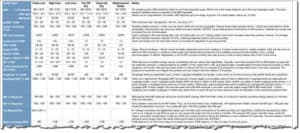My experience working with AMTS is a little of a coming home story. I attended Cornell University in the early 1980’s. I went there because I grew up on a small Jersey farm and wanted to be a large animal veterinarian. A few semesters into pre-vet classes I realized I enjoyed Dairy Nutrition far more and changed my focus. I was fortunate enough to work for Charlie Sniffen and take classes from Peter VanSoest. The feeding programs I used were the precursor to the model. I married a fellow Cornell Dairy Science major and we moved to his family farm 20 miles away from Cornell to start our family. We had four children and I began a career as a garden designer because that fit nicely with being a farm wife and a mother. My husband’s family dairy is fairly large and our proximity to Cornell kept us in close contact with people in the department. We were neighbors with Danny Fox and friends with Mike VanAmburgh so the development of the CNCPS model was not infrequent diner conversation; our oldest son, Sam, is even planning to come to Cornell for his PhD under Mike after he finishes his masters at the University of Minnesota. When the opportunity to work with the AMTS group presented itself last year I gleefully jumped at the chance to work in the area I studied. I am not feeding cattle but I need to understand the science behind the model if I am going to write about it. Having concentrated on other things the last 25 years, my learning curve has been steep. I read everything I can, ask incessant questions, and listen. Fortunately, the group has been fantastic about supplying resources for remedial nutrition information. When Sam visits, he and I huddle around our computers running rations and comparing results. He points me to good information sources—thank goodness he is so patient with me. Sam actually provided me with this summation–my go to description of working with CNCPS through AMTS
Systematic modeling is an excellent tool; however, the use of many dynamic models requires two key components. 1) The user MUST have a comprehensive, up-to-date training in ruminant nutrition AND an understanding of the practical limitations of feeding systems. 2) Inputs into the model must be characterized correctly. The model is only as good as the data provided to it. This point emphasizes the need to properly characterize the system to be modeled. In the CNCPS, this is mainly done through the Feed Library, Cattle characteristics, and Environmental parameters. The more information you can provide, the greater your ability to predict outcomes. Unfortunately, for those modelers with perfectionist tendencies, the most accurate models are often the least applicable. The developers of the CNCPS have fairly successfully balanced this paradox , creating a fairly accurate model that still can be used on-farm.
One of my tools is the Dairy Evaluation Matrix Tom has put together. The spreadsheet packs a lot of information into a single document. It provides min/max guidelines for the critical nutrient outputs. Extensive notes in each category expands some of the information behind the recommendations, “the why of it” as one of my professors used to say. The Dairy Evaluation Matrix is available at the website and in the User’s Manual within the Program.

